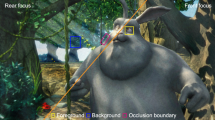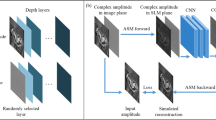Abstract
Self-referential holographic data storage (SR-HDS), which has been proposed as a novel implementation method for holographic data storage (HDS), enables holographic recording without a reference beam. In addition to the signal pattern (SP) to be recorded, an additional pattern (AP) that affects the reconstruction quality is used in SR-HDS. One of the methods for obtaining a designed AP that contributes to high-quality reconstruction involves utilizing local search algorithms, such as the hill climbing (HC) method. However, designing an AP using this method typically requires a significant amount of time. In this study, we proposed a new AP-designing method that uses a deep neural network. By training a network with pairs of SP and designed AP based on a local search algorithm, a designed AP that improves the reconstruction quality of an arbitrary SP can be instantly obtained. APs designed using the deep learning-based method improved the reconstruction quality of SPs to the same level as those designed using the method based on local search algorithm, whereas the time required to obtain one designed AP was reduced by three or four orders of magnitude.

















Similar content being viewed by others
Data availability
All data supporting the findings of this study are available from the corresponding author upon reasonable request.
References
Katano, Y., Nobukawa, T., Muroi, T., Kinoshita, N., Ishii, N.: CNN-based demodulation for a complex amplitude modulation code in holographic data storage. Opt. Rev. 28, 662–672 (2021)
Kurokawa, S., Yoshida, S.: Demodulation scheme for constant-weight codes using convolutional neural network in holographic data storage. Opt. Rev. 29, 375–381 (2022)
Zhao, Y., Wu, F., Lin, X., Zhang, M., Yu, Q., Tan, X., Xie, C.: Phase-distribution-aware adaptive decision scheme to improve the reliability of holographic data storage. Opt. Express 30, 16655–16668 (2022)
Bunsen, M., Umetsu, S., Takabayashi, M., Okamoto, A.: Method of phase and amplitude modulation/demodulation using datapages with embedded phase-shift for holographic data storage. Jpn. J. Appl. Phys. 52, 09LD04 (2013)
Katano, Y., Muroi, T., Kinoshita, N., Ishii, N.: Highly efficient dual page reproduction in holographic data storage. Opt. Express 29, 33257–33268 (2021)
Hao, J., Lin, X., Lin, Y., Song, H., Chen, R., Chen, M., Wang, K., Tan, X.: Lensless phase retrieval based on deep learning used in holographic data storage. Opt. Lett. 46, 4168–4171 (2021)
Mok, F.: Angle-multiplexed storage of 5000 holograms in lithium niobate. Opt. Lett. 18, 915–917 (1993)
Rakuljic, G.A., Layva, V., Yariv, A.: Optical data storage by using orthogonal wavelength-multiplexed volume holograms. Opt. Lett. 17(20), 1471–1473 (1992)
Horimai, H., Tan, X.D., Li, J.: Collinear holography. Appl. Opt. 44, 2575–2579 (2005)
Jia, W., Chen, Z., Wen, F.J., Zhou, C., Chow, Y.T., Chung, P.S.: Coaxial holographic encoding based on pure phase modulation. Appl. Opt. 50, H10–H15 (2011)
Tanaka, K., Hara, M., Tokuyama, K., Hirooka, K., Ishioka, K., Fukumoto, A., Watanabe, K.: Improved performance in coaxial holographic data recording. Opt. Express 15, 16196–16209 (2007)
Qiu, X., Wang, K., Lin, X., Hao, J., Lin, D., Zheng, Q., Chen, R., Wang, S., Tan, X.: Combination compensation method to improve the tolerance of recording medium shrinkage in collinear holographic storage. Photonics 9(3), 149 (2022)
Takabayashi, M., Okamoto, A.: Self-referential holography and its applications to data storage and phase-to-intensity conversion. Opt. Express 21(3), 3669–3681 (2013)
Takabayashi, M., Okamoto, A., Eto, T., Okamoto, T.: Shift-multiplexed self-referential holographic data storage. Appl. Opt. 53(20), 4375–4381 (2014)
Takabayashi, M., Okamoto, A., Eto, T., Okamoto, T.: Recording procedures for high-quality signal readout in self-referential holographic data storage. Appl. Opt. 54(16), 5167–5174 (2015)
Eto, T., Takabayashi, M., Okamoto, A., Bunsen, M., Okamoto, T.: Numerical simulations on inter-page crosstalk characteristics in three-dimensional shift multiplexed self-referential holographic data storage. Jpn. J. Appl. Phys. 55(8), 08RD01 (2016)
Takabayashi, M., Eto, T., Okamoto, T.: Numerical simulations on the focus-shift multiplexing technique for self-referential holographic data storage. Opt. Rev. 23(6), 987–996 (2016)
Tomioka, R., Takabayashi, M.: Numerical simulations on optoelectronic deep neural network hardware based on self‑referential holography. Opt. Rev. 30, 387–396 (2023)
Saita, Y., Nomura, T.: Design method of input phase mask to improve light use efficiency and reconstructed image quality for holographic memory. Appl. Opt. 53, 4136–4140 (2014)
Chijiwa, K., Takabayashi, M.: Fast designing method of additional patterns in self-referential holographic data storage-approach using deep neural network-. ITE Tech. Rep. 47, 35–40 (2023). (in Japanese)
Ronneberger, O., Philipp, F., Brox, T.: U-Net: convolutional networks for biomedical image segmentation. In: International Conference on Medical Image Computing and Computer-assisted Intervention, pp. 234–241 (2015)
Kang, S., Uchida, S., Iwana, B.K.: Tunable U-Net: controlling image-to-image outputs using a tunable scalar value. IEEE Access 9, 103279–103290 (2021)
Laxman, K., Dubey, S.R., Kalyan, B., Kojjarapu, S.R.V.: Efficient high-resolution image-to-image translation using multi-scale gradient U-net. In: International Conference on Computer Vision and Image Processing. Springer International Publishing, Cham (2021)
Ohyama, W., Suzuki, M., Uchida, S.: Detecting mathematical expressions in scientific document images using a u-net trained on a diverse dataset. IEEE Access 7, 144030–144042 (2019)
Ibtehaz, N., Sohel Rahman, M.: MultiResUNet: rethinking the U-Net architecture for multimodal biomedical image segmentation. Neural Netw. 121, 74–87 (2020)
Tanaka, J., Okamoto, A., Kitano, M.: Development of image-based simulation for holographic data storage system by fast Fourier transform beam propagation method. Jpn. J. Appl. Phys. 48, 03A028 (2009)
Author information
Authors and Affiliations
Corresponding author
Ethics declarations
Conflict of interest
On behalf of all authors, the corresponding author states that there is no conflict of interest.
Additional information
Publisher's Note
Springer Nature remains neutral with regard to jurisdictional claims in published maps and institutional affiliations.
Rights and permissions
Springer Nature or its licensor (e.g. a society or other partner) holds exclusive rights to this article under a publishing agreement with the author(s) or other rightsholder(s); author self-archiving of the accepted manuscript version of this article is solely governed by the terms of such publishing agreement and applicable law.
About this article
Cite this article
Chijiwa, K., Takabayashi, M. Deep learning-based design of additional patterns in self-referential holographic data storage. Opt Rev 31, 28–40 (2024). https://doi.org/10.1007/s10043-023-00856-2
Received:
Accepted:
Published:
Issue Date:
DOI: https://doi.org/10.1007/s10043-023-00856-2




